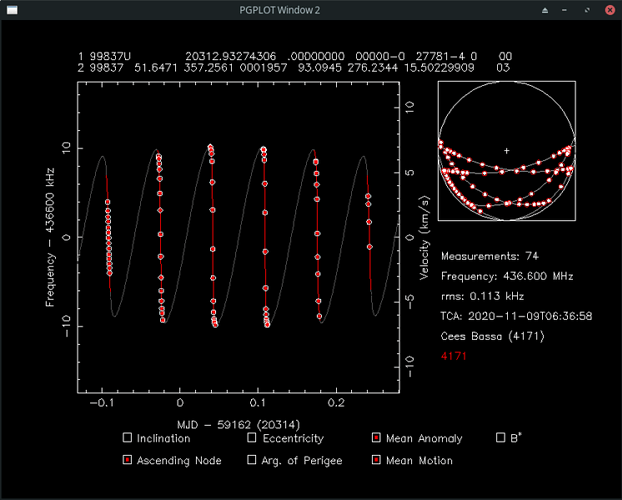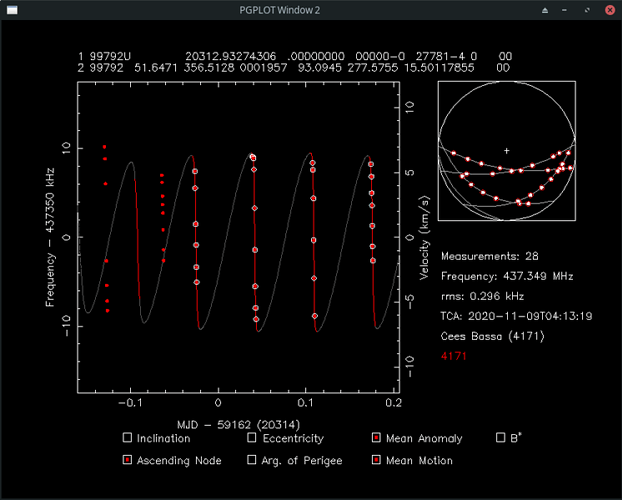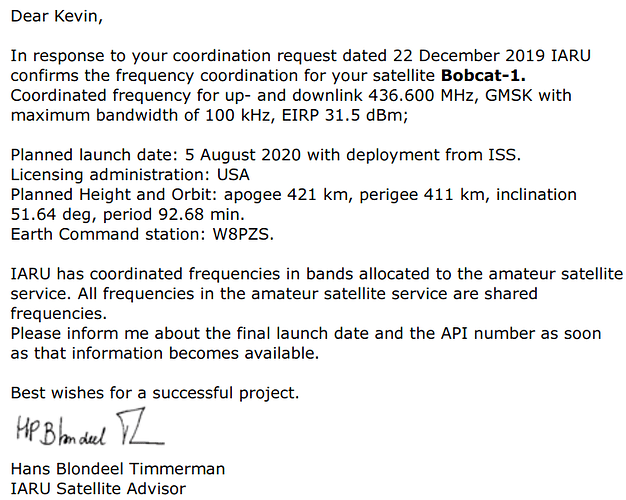I tested and rated a NanoCom for our next CubeSat, so I also follow the CubeSats in-flight using this board. I am surprised however that the IARU coordinated your satellite for a 115k2 transmission. The bandwidth should be greater than 25kHz, there is a special mendatory for that ?? I am interested in this information. Congratulations for Bobcat
New BOBCAT-1 and SPOC TLEs based on STRF monitoring of the UHF band from station #40. These TLEs are based on the ISS TLE, updating mean anomaly, mean motion and RA of the ascending node.
BOBCAT-1
1 99837U 20312.93274306 .00000000 00000-0 27781-4 0 00
2 99837 51.6471 357.2561 0001957 93.0945 276.2344 15.50229909 03
# 20201108.91-20201109.24, 74 measurements, 0.113 kHz rms
SPOC
1 99792U 20312.93274306 .00000000 00000-0 27781-4 0 00
2 99792 51.6471 356.5128 0001957 93.0945 277.5755 15.50117855 00
# 20201108.97-20201109.18, 28 measurements, 0.296 kHz rms
I will gladly have my station available to detect and verify violations. Without observing, we would not be aware of the violation.
Maybe a better option is to disable uploads of audio and decoded data for violating transmitters? That way we can still detect, but will prevent some of the practical (mis)use.
TLE for Bobcat-1 and SPOC are updated now.
You are right, it should be a better solution than mine. The main goal is not to make any police, but prevent to help “bad users”, especially if there is a commercial interest, who don’t care about regulation.
if you are still considering the AX100 for your cubesat, let’s talk  Send me a PM.
Send me a PM.
We were surprised as well. We requested 120KHz of bandwidth and were coordinated for 100KHz:
When requesting coordination for a frequency, it helps to look who is already there so you don’t pick a crowded spot. I suggest looking here, and clicking “Spectrum”: SatNOGS DB - Transmitters
I have received updated TLEs from the US Space Force. Please see attached:
“Hi Kevin, I’ve got updated TLEs, though still not ready for prime time. They still think Bobcat is either 85416 or 85419.”
NRCSD-19 Cubesat TLEs 09Nov20.txt (1.1 KB)
Good passes of Bobcat-1over europe yesterday at 22:30 PM UTC, the beacon period seems to be 10 sec, but there is a mix of 1200bauds frame with others that I didn’t decode. Thanks for the coordination informations.
Bobcat-1’s beacon period should be a short beacon every 29 sec and a long beacon every 30 sec, and at that time we were only running at 1200 baud. It sounds like you are being affected by AISTECHSAT-2’s ongoing interference. See here: NG-14/ELaNa 31 Launch and Deployment Information
Bobcat-1 will operate at 38k4 from 03:52UTC to 22:13 UTC. We’ll be downloading collected science data during passes over our groundstation during this period, and are leaving the baud rate set to 38k4 to allow people to test their groundstations and see if they can decode the higher baud rates. After 22:13, we’ll revert back to 1200 baud.
All observations of Bobcat-1 between 2020-11-11 03:52UTC and 2020-11-11 22:13 UTC have been updated to 38k4. The rest remain at 1k2.
Thanks for the heads-up! All ready here in Virginia.
Is there any decoder or guidance online for the telemetry being downloaded? Great fun to decode the raw hex bytes but it’s even more interesting if we can put meaning to the data.
Good luck!
-Scott, K4KDR
For the big data downloads, we are generally just downloading files that contain binary messages from our primary payload, a NovAtel OEM719. You should be able to (essentially…) concatenate the packets together (need to account for CSP retransmissions somehow) and then decode them as binary novatel messages according to this manual: https://docs.novatel.com/oem7/Content/PDFs/OEM7_Commands_Logs_Manual.pdf
I’d like to put some effort into making a tool that reconstructs files transferred via GOMSpace FTP from just the cubesat’s packets, but I’m a bit too busy right now. I’m pretty sure it’s possible. If anyone is interested in this, let me know and I can give you some guidance on how to get started.
Thanks for watching for us! Looking forward to seeing what you get.
Regarding the Bobcat-1 downlink format, thank you very much for the documentation!
I noticed in particular regarding that Binary Message Format:
2. The 3 Sync bytes will always be:
Byte Hex Decimal
First AA 170
Second 44 68
Third 12 18
… however, after receiving several strong 38k4 downlinks with hundreds of packets decoded, I have not found a single instance of that byte string. Is the team receiving readable data in this Binary Message Format?
Thanks for any info!
-Scott, K4KDR
Hey Scott,
I just found out that the info I gave you was incorrect - the OBSW team changed the data format a while ago and I was not aware. Sorry about that. We are receiving readable data, and hopefully on the next passes overnight (EST), we’ll be getting a lot more data.
We are not compressing the data with gzip/anything similar due to limitations on code-size, so instead we made a custom file format that strips info out of the novatel messages that we don’t need for our science goals, and repacks the remaining info with a new sync header. The sync bytes should be ASCII “KEV”.
I unfortunately cannot share our message decoder since it’s built into a proprietary internal tool, but I can share the message format. The team will review the doc to make sure it’s up to date and then I’ll share a file soon that describes our the custom messages in our files.
I hope you’re able to find and decode a BESTPOS message (contains LLH) - it would be cool to see an amateur radio operator decode the cubesat’s (former) position!
Thanks,
Kevin
P.S. I didn’t know the sync bytes were KEV until long after - that was a surprise from the team!
Thanks very much for the update!
Yes, the data is full of “KEV”, so I wondered what that was about.
Appreciate any additional info as it becomes available.
Thanks!
Hey Scott,
I have a C header file with definitions for our message types, as well as a document describing the messages. Unfortunately the forum is really inflexible in what I can post, so I have uploaded the Excel sheet (.xlsx) as a .txt. Just remove the .txt extension and it should open up fine 
bobcat1.h.txt (6.3 KB)
BOBCAT-1 FILE FORMAT.xlsx.txt (26.1 KB)
If you have specific questions related to this, please send an email to my team member Ryan - his email is located in both files.
Thanks,
Kevin
That’s great info - thanks a million for sharing!
I spent a good deal of time on the large 38k4 data dump from 9-Nov where there were hundreds of “KEV” sync markers. However, while patterns were evident it was a bit much for me to be able to understand what sections might have been a BESTPOS report.
I will email Ryan to see if I can learn a bit more about how the raw data can be parsed. The ability to extract even partial “real world” data from a downlink does a lot to encourage more participation from the Amateur Community. The call signs are ASCII, so that’s a great start. But the ability to see real telemetry is a nice value-add.
Thanks again!
New TLE set for Bobcat-1:
Bobcat-1
1 99837U 20318.70833333 .00000000 00000-0 27781-4 0 02
2 99837 51.6471 328.6247 0001811 106.2447 116.4864 15.50355586 02
Bobcat-1 is now transmitting at 57k6 baud rate.


